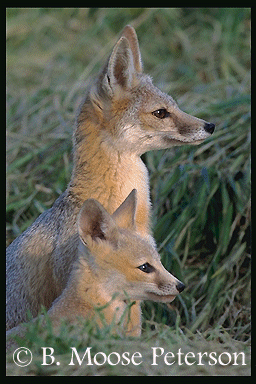San Joaquin Kit Fox

Home Sweet Home
San Joaquin kit foxes are found in arid grasslands, scrub lands, and foothills of the San Joaquin Valley. The kit fox builds an oblong-shaped den in loose soil. These burrows may have as many as 2 to 24 entrances. A fox family may have more than 30 dens over nearly 600 acres of territory, and may move from one den to another during the year. Sometimes these tiny foxes will den near cities in road culverts, and in abandoned pipelines in oil fields.
Air Conditioning Ears
People who live in Kit fox type habitat would have a hard time in the summer without air coolers. This tiny, big-eared fox has developed an amazing way to stay cool. The huge ears of the kit fox not only give it good hearing ability, but help the animal to lose body heat. As blood circulates in vessels close to the ear's surface, it helps dissipates body heat.
A Built-in Canteen
Another interesting adaptation to a hot, dry habitat is the kit fox's ability to extract enough water from its food to go without drinking water for long periods of time.
A Helpful Predator
Mostly a nocturnal hunter, the kit fox eats rabbits and hares, ground squirrels, mice, and kangaroo rats - animals that farmers consider to be pests. It also eats insects and some grasses. The kit fox may range several miles a night in search of food.
Females give birth to four or five tiny pups in February, March or April. The young remain in the den until they are about a month old. After that, they may be seen playing or resting outside the burrows in the morning and late afternoon. The family splits up in the fall, as the young ones leave to find their own home range.
"Then.....
San Joaquin kit foxes once ranged throughout much of the southern San Joaquin valley, from near Tracy in San Joaquin County, south to Kern County. By 1930, this range declined by almost 50%, and kit foxes were eliminated from much of the northern and eastern parts of their range.
".....and Now"
Today San Joaquin kit foxes occur in what remains of their native vegetation habitats in the San Joaquin valley and surrounding foothills, from Los Banos in Merced County in the north, south to San Luis Obispo and Kern County. Isolated populations of the foxes have also survived in a few parts of it's original range in Alameda, Contra Costa, Santa Clara, and San Benito Counties.
Agricultural and residential development in the San Joaquin Valley since the completion of the California Aqueduct, is a main cause of the fox's decline in range and numbers. Other threats include shooting and trapping, dogs and coyotes, collisions with cars, oil-field development, and poisoning from chemicals that ranchers use to kill rodents. Because the kit fox needs a very large territory - about one square mile per animal - it is hard to protect. Fragmentation of habitat in the northern part of the kit fox's range (east and south of San Francisco) threatens to eliminate the northern population.
Set Aside Habitat
On the Carrizo Plain, about 82,000 acres is managed as the Carrizo Plain Natural Heritage Reserve. This land helps to protect habitat for the kit fox as well as other threatened or endangered species. San Joaquin kit fox habitat is managed at Tule Elk State Reserve, Kern National Wildlife Refuge, Pixley National Wildlife Refuge, the Carrizo Plain Natural Area, and Success Lake near Porterville. At Kern National Wildlife Refuge, managers constructed artificial dens for the foxes.
Work Together
The California Department of Fish and Game, the US Fish and Wildlife Service, and the Bureau of Reclamation, cooperate on a strategy to protect habitat for the San Joaquin kit fox. The town of Bakersfield wrote a Habitat Conservation Plan for their community, and purchased habitat using conservation funds from development fees. California tax check-off funds are used to support California Department of Fish and Game research and management to benefit the estimated seven thousand San Joaquin kit foxes left in the wild.

